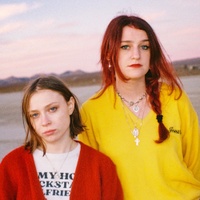On having a master plan
Prelude
For the last 24 years, Tunde Adebimpe has largely been known as the co-founder, co-vocalist and principal songwriter for TV On The Radio. The mostly-black, art-rock band triumphed through two decades of volatile cultural change to become one of the most beloved, enduring and influential groups from New York City’s early-2000s rock scene. Though Tunde’s poetic songwriting and transparent, towering vocals are central to the band’s dissonant sound, TV On The Radio has and always will be a collaboration between a group of singular musicians.
Tunde’s personal story exists on a parallel path, as a sort of creative polymath. He is a musician but also an illustrator and painter. He’s a former animator and one-time stop-motion filmmaker. He is a television and film actor. And now he is also a solo artist, with his first-ever formal solo album, Thee Black Boltz (Sub Pop, 2025).
Conversation
On having a master plan
Musician, actor, and visual artist Tunde Adebimpe discusses grief, collaboration, and having a place to land
As told to Jeffrey, 2801 words.
Tags: Music, Acting, Art, Collaboration, Time management, Mental health, Focus.
The Black Boltz served as a guiding theme as this record came together. How did that theme make itself known?
Thee Black Boltz came out of some free writing I was doing. It was a pretty heavy time while I was making it as far as grief and subsequent depression kicked in. Working on art or music is a good way to organize the messier or abstract feelings, it’s a place you can put those so you’re not just a person in the world swimming in all these thoughts.
The Black Boltz is a metaphor viewing that depression or grief as storm clouds, when they coalesce, whatever positive or negative electrons or neutrons that smash together can yield lightning, which can illuminate a path forward that also shows you the beauty in all of that darkness, which to me is the other side of grief. You only feel so bad when you lose something because you loved them so much, or you may lose someone because it’s directly proportional to the amount of love and unspoken love that you had for this person.
Maybe the Black Boltz are these songs, or the impetus for these songs is just jotting down or documenting those flashes of inspiration that helped me go forward. This record is a way to honor those people that I’ve lost who really helped me along the way. It is strange when it’s the people who directly inspired me to want to make art or music, many of those people are the ones who passed. This was a good way to keep them in the world for myself. And also the songs are multi-purpose, whoever needs to use them, that’s the way I hope it lands in the world.
You’ve said the importance of making art is that when you walk away, you’ve altered, gotten rid of, or imported something. I’m assuming that was the case with this one.
Absolutely. If you live long enough you’re going to lose someone, you’re going to experience, I hope it’s not clinical depression, but you’ll experience extreme periods of sadness or things not going your way. Even just looking at the world and wondering, is this it? All we got is just being fucking hateful, murderous people, that’s it? It’s just life, but I feel as someone who’s making art or has this mechanism to process, and when I say process, it can be therapeutic. The act of someone throwing a bunch of dust at you and you’re just like, “Okay, I’m going to turn this into little mud balls and place them over here so they make some kind of sense and I’m not swimming in this mist.”
How does seeing your ideas through as a solo artist differ from operating with a band?
I have no problem telling people what to do now. I also want to make it as easy for them as possible. I want to help them out by saying, “Here’s the storyboards, here’s the map that we can all collaborate on.” Much in the same way as it goes with a band. You find people who are better than you at what they do and say, “I would love for you to have fun with this because I know that you’re great at what you do, and I want to see what that yields.”
In terms of demo writing and going from 80 to 100 percent, it was good, because it was the way I started making music on a four-track, just beatboxing, a cappella and a little bit of keyboard. Back then I would make demos and burn a CD of them and give it to a friend or make copies. We’d trade stuff, without having the idea they would be more realized. I didn’t have any idea I would be in a band.
It was going back to that, making a strong enough demo for people to get ideas and springboard off of instead of, as I would with the band, knowing that I’m going to get to here, but I know for sure that Jaleel’s going to have a great idea here, Dave’s going to have a great idea, or Kyp will do something awesome here. That part was exciting, the uncertainty, not knowing who I was going to collaborate with and how.
You used a “dry paint/wet paint” framework for deciding which ideas needed elaboration and which to leave as is. How did that play out?
The wet paint, dry paint shorthand developed between Wilder Zoby and I. l have a tendency, if something doesn’t feel exactly right, I can go back to the point of obsessing. Lyrically or with harmony. Since that’s my department on the song, I’ll just be like, “That’s not right. I don’t know what’s not right about it.” It’s almost like a painting, sometimes you get to a point and you think that area over there, something’s not sitting right with me so I’m going to keep working on it. Then you realize you’ve completely fucked it up and it’s a mess. Maybe if you’d just gone for a walk or something, you would’ve come back and not even noticed it. So we had a shorthand with the songs where we’d get them to a certain point and just feel like, okay, that’s done. We’ve taken that to a point where we both looked at each other and gone, “This feels right, this feels good in the moment.” When we were doing a final review of all of the songs there were some things that were obvious, where it was just like, “I’m going to go in and fix that because this sounds weird,” or there was a technical thing wrong with it. There were other things that were more feelings-based or lyrics I was unsure about. You get in your head about lyrics more than anybody who hears the final will, because they have no idea what the 20 versions of this thing were before they hear it.
I forget that every time I’m making a record.
We do forget it. There’s songs in the past with TV on the Radio, where as soon as it’s out in the world, I hear it and I’m just like, “Why didn’t I change that?” No one cares or knows. So the wet paint, dry paint thing showed up. It’s great to have a collaborator or somebody who’s aware of what you’re doing that you can use as a sounding board. Even while we were mastering it, I was like, “I think I want to add that thing that I’ve been thinking of.” And Wilder would go, “I’m going to say it’s dry paint.”
Then we’d take a little survey with whoever else was in the room, and they’re like, “I don’t know what the fuck you’re talking about, I think that’s fine.” Even if I felt uncomfortable about it, on this record more than anything else I shrugged and said, “You know what? I feel weird about that.” But also I love things that are kind of awkward, I like the handmade nature of things. Increasingly I like to see a human hand in something, imperfections.
How long have you had your journaling practice?
I am not as disciplined about it as I would like to be every day. I don’t remember when the first edition came out, but The Artist’s Way, the Julia Cameron book. Someone gave it to me, and the first thing I thought was, come on, this is a workbook. It was like, no, I get up and I’m bummed out. I go to my job at The Angelika and I’m sad, I come home and I do what I’m going to do. You just fuck around wonder where the time is going.
So they gave it to me and I was like, “I’ll try it out for a week.” I ended up going through the whole thing and doing the morning pages where she encourages you to write three notebook pages a day, to free-write and not look back at it. You don’t look at it for maybe a month as a way to clear everything out of your head in the morning and put it in a place, put all your messy and serious thoughts in one place and then don’t look at it.
It’s almost like going for a run in the morning. You’re like, I’m going into the world and getting ready to go and be a person without having all of these little knots tied up. I’ve tried to do that since I got that book, which was probably in the late 90s. I have gone back to some of those journals, I’ve got a box of them over there for ideas. I also draw in the margins of some of those. Some of those little dumb sketches can end up as drawings or a painting. I took that idea and did a lot of free writing and drawing in this book, specifically for this record. This started May 16th, 2021 as a way to reorganize my thoughts and have a master plan to go into this record.
About a week after I signed to Sub Pop, there was another part of this whole, what do I like about making music? I had gone to all these labels and no one cared. Then I thought, what about Sub Pop? Maybe they’d be interested. They’re definitely in that pantheon of labels that put out music that made me realize I could probably make music, and influenced the way I thought about music, scenes ,and who I wanted to be around. I brought the demos to them and they were super on board immediately, which was a big lift for me. A week after that, my sister passed away suddenly.
I’m the only immediate family in the country. My mom’s in Nigeria, it was just me. I had to go and deal with all of that, doing a ceremony, everything. I came back and just essentially was like, “I don’t want to do anything ever again. This is the closest person in my life.” It was mid-pandemic, so it was all of that stuff you have to do when somebody passes, in masks, you set up a Zoom funeral. It was a pretty heavy time. That was in March, and this says, May 16th, 2021.
Three months after, I was like, “You know what, not only do I owe someone a record.” Sub Pop was just like, “Take as much time as you want.” And I was like, “I don’t want to hear that because I’d like to get it done, and I feel like it’s the best use of my time in the middle of this grief and everything surrounding it.” It’s good to have a place to land. I had the record title already, and here in my journal it says, “Boltz Master Plan, May 16th.” Then it said, “May 17th to June 4th, demo and organize. June, July, August, work. Turn the record in in September.
I wrote, “cohesion, a strict schedule, unplug everything to work, make a sonic bed. The sonic bed is where you rest now until the years end, all other projects get turned off.” That starts, then I have a page here that essentially says, “Focus on demos first, new batches every week. I want violins, some digital, mostly organic sounds. Look it up, make a mixtape of how you’d like things to go.”
This record has the feeling of a mixtape that a friend would’ve given to me in high school, and of a mixtape that friends did give to me in high school. There are all these inspirations, and this was just on one day. The first tier of inspiration–Fever Ray, Little Dragon, Bjork, Homogenic. Gary Newman, Stooges, Raw Power, Rain Dogs, Odelay, Mellow Gold, Nation of Ulysses, Nick Drake. Second layer, Tinariwen, Howlin’ Wolf, Choirs, bones in a stone room, which is not a band, it’s just a feeling and sound.
Organic, Super Onze, which is a Malian Griot band. Listen to Bahia, Manu Chao, Congotronics. Then the third layer, words, sound, spoken word, glitch. There are sketches for what the album art might look like. Then it says for dance tracks, listen to some house, footwork, techno. Apply that to Conga and Calypso, mix and match. Eight songs, three interludes. That was the first deal of this is what I want to fucking do.
What are some creative throughlines that allow you to stay engaged in your work?
When I started out, I thought I would be a comic artist, specifically an underground cartoonist. Then I wanted to make films, short films and music videos, and acting came out of that. Then making stop motion was also sort of a, “I can do this,” just make the thing that I want to see.
Which by the way, it never turns out exactly the way I want to see it. But also accepting that. It’s going to be something close to the idea or completely different, which is also totally fine. It’s in collaboration, finding people who are in a lot of ways better than you at what they’re doing. Bringing them in and getting to a place of play. Everybody tries to be their best selves creatively when you bring people in who are very good at what they do, and you encourage them to go in a direction that makes the most sense for them. And push it to be like, “If we all get down on this one mural,” whatever, the technical mural, whether it’s a record or a video or something, and we’re all excited to see it, then that’s the best place we can possibly be.
It’s also trusting this mechanism of processing the world. As long as I’m still in the world and as long as I’m moving forward. A friend of mine, a sculptor named Janny Baeck, we’re thinking about life in terms of you get born then you’re shoved along by this invisible hand, all of these things come at you and you have to figure out a way to reconfigure them so they get out of your way. Or reconfigure them so that they become a part of you, or so that you can use them to help other people.
Mostly it’s realizing that you’re going to be pushed forward, and that time is here and we’ve got to spend it. We don’t have anything, there’s nothing we can do but spend that time. The throughline is that it all feels like a doable collage. All of these separate elements of your outside life and your inner life and the events of the wordl. It’s all stuff to pull from and turn into something else. Sometimes that’s a job and you get paid for it, and sometimes it’s just what you do.
TCI founder Brandon Stosuy’s essential Tunde Adebimpe:
In no particular order, mostly
TV On The Radio performing “Wolf Like Me” on David Letterman in 2006. Tunde’s singing here is mind-blowing. The band meets him at that level.
As they always did…TV On The Radio is maybe one of the best live bands I’ve seen. I’ve seen them dozens of times, in the same era as the Letterman performance (and earlier and later) at places like Black Betty, Northsix, at the Siren Festival (RIP), etc. There was nobody like them (still isn’t). I think the first time I saw them was at the Mercury Lounge and my eyes teared up from pure excitement.
I liked all their albums, but I come back to these most often: Young Liars EP (2003), Desperate Youth, Blood Thirsty Babes (2004), Return to Cookie Mountain (2006), and Dear Science (2008). I don’t say many things are perfect, but Young Liars is, for sure. I still remember hearing it for the first time and being so excited about it. If you don’t know the band, start with these early records, in order of when they came out—it’s so cool to see what shifts and expands and what essential parts stay the same.
Tunde’s voice work on shows like Celebrity Deathmatch, Lazer Wulf, Tuca & Bertie, Pantheon, etc. Those… and his acting work as well, where you do get to see him—like his “scene stealing” performance in Twisters.
I think it’s worth following Tunde’s smart, thoughtful Instagram. He keeps updating it, as one does with social media, and its worth keeping up with his takes. For instance, his thoughts on comfortable silence and eye contact on the subway.
- Name
- Tunde Adebimpe
- Vocation
- musician, actor, visual artist
Some Things
Pagination



